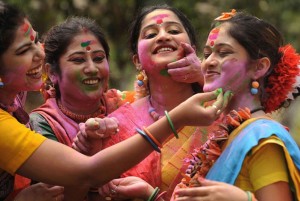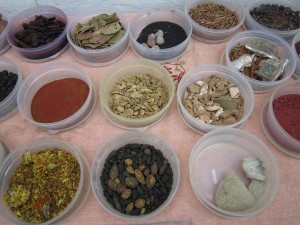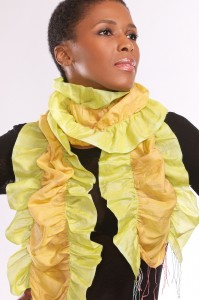Colors of India & the Holi Festival
It could be said that color is the spice of life.
Consider what this world would be like if we only had browns and greys to look at. It is no accident that vibrant color is found in nature. In fact, most natural dyes are made from various plant parts – including some that are also used for spice in cooking.
India is a country vibrating with color. The colors of India are an inherent aspect of the whole experience of the country and visitors are often captivated by their exuberant use of color. There is a special day of celebration called “Holi Festival” where Indians revel in the arrival of spring. Everybody enters into the excitement of Holi with great anticipation. As it marks the arrival of spring, the season of hope and joy, nature also it seems to rejoice at the arrival of Holi, as fields fill with crops promising a good harvest to the farmers and flowers bloom and fill the air with sweet fragrance.
In these modern times, as the spring-blossoming trees that once supplied the colors used to celebrate Holi have become more rare, chemically produced industrial dyes are being used instead in almost all of urban India. Due to the commercial availability of various attractive color pigments, the natural colors are being replaced by synthetic colors. These synthetic powders can cause mild to severe symptoms of skin irritation.
In the world of textiles as well, these synthetic dyes have largely replaced the use of natural plant and mineral based dyes. These chemical dyes pollute the environment and create significant health hazards to the people dying the yarns and textiles. Natural dyes have a more limited color range, but do offer significant benefits to the environment, the artisans, and the person wearing the product. Sevya's Ayurvedic Scarves are dyed with 100% natural dyes, which also have medicinal benefits.
Color is an intricate and significant aspect of the cultural and religious traditions of India. The stories and legends that bind its people, its culture, and its beliefs are all full of color. The "rani" pink of mystical Rajasthan, the pastel hues of southern India, the joyous, bright hues of the northern frontier, and the balmy bright colors of the east offer a kaleidoscopic insight into an almost perfect blend of history and modernism.
Green symbolizes a new beginning, harvest, and happiness. Green signifies life and energy. The color green gives us a sense of relief, comfort, and love, and also symbolizes nature. Turmeric powder (Curcuma domestica) and Indigo can be used together to create green.
Yellow is the color of self-confidence. It is also a happy color – bold and full of energy. Yellow also symbolizes wisdom. Yellow means joy and happiness. Marigold, Turmeric and Saffron can all be used to create yellow.
Blue is a color of self-expression and deep thinking. It is one of the coolest colors. It speaks of life. It is the color of skies, ocean and twilight. Some ancient civilizations like the Egyptians used this color to represent heaven. Blue also has a calming effect and symbolizes serenity, tranquility and spirituality. Indigo is used to create a deep blue.
Pink is thoughtful and caring. It tones down the physical passion of red, replacing it with a gentle loving energy. Pink is also intuitive and insightful, showing tenderness and kindness with its empathy and sensitivity. Hibiscus and the Rose Mallow are used to create various shades of pink.
Red is a mark of matrimony. Brides in India wear red most often at their wedding since it symbolizes fertility, love, beauty, and is a sign of a married woman. Married Hindu women wear red powder (Kumkum) on the peak of their forehead, or as a dot in the center of their forehead. Kumkum is made from dried Turmeric mixed with slaked lime. Madder and Soapnut Pericarp are also used to create the natural red dyes.
Sevya continues to seek new creative partnerships with the many talented artisans of India. We spend considerable time researching how fabrics are dyed, making sure to uphold our commitment to care for humanity and the environment we live in. Our wholesale fair trade scarves represent all the colors of India, both in vivid contrast and in pastel subtly.
Try to spend one-day paying attention to all the colors around you. Perhaps today you will see color in a whole new way and find understanding of its pulse. Maybe you’ll take a new color road and bring a whole new hue to your life. Our colorful scarves are a great way to experiment with adding some flair to your wardrobe.
Be sure to look up Holi Festival – March 27th, 2013. This is the date for one of India’s most unique festivals – and India celebrates a LOT of festivals.




